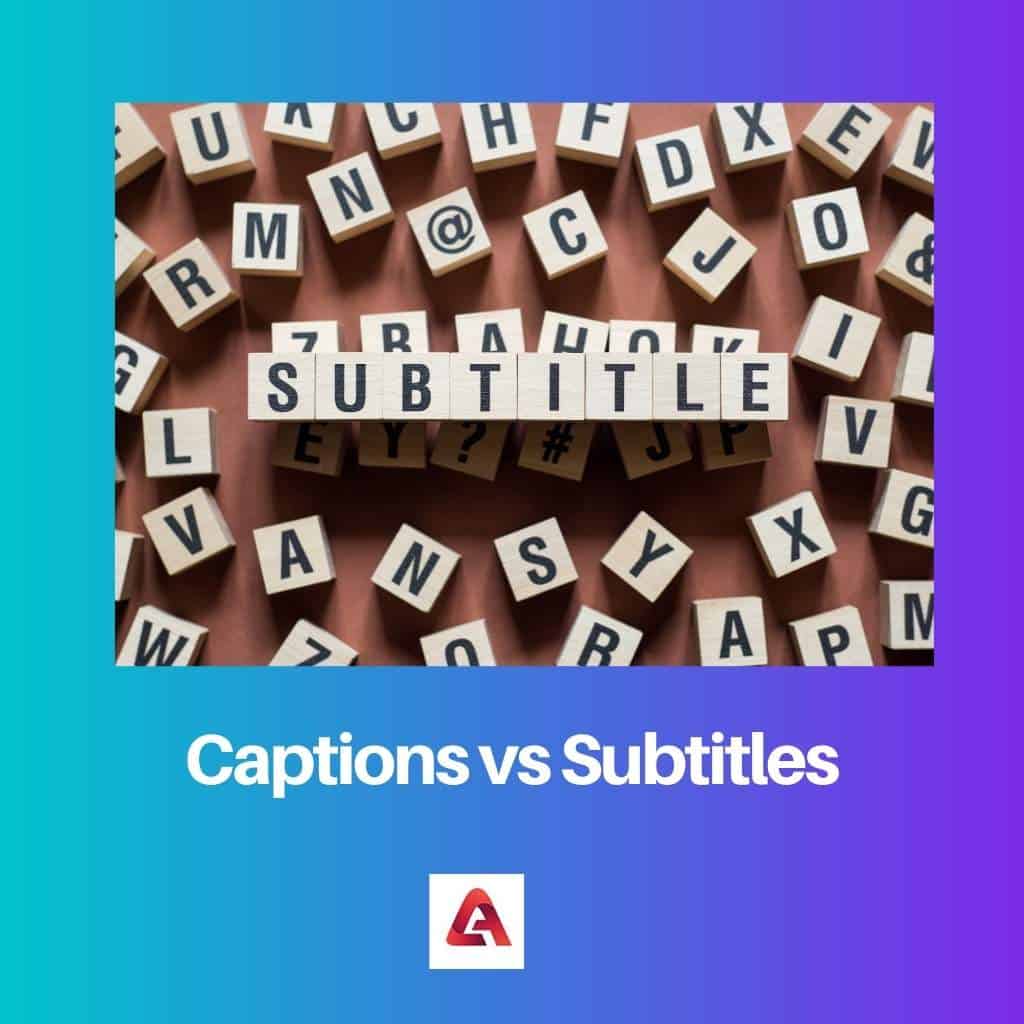Displaying words on the screen, along with the visual media, is very important, as it helps to propagate the media to people who are not familiar with the language.
Movies and TV shows that are not written in English are displayed along with the translated dialogues to help viewers better understand the story.
Key Takeaways
- Captions provide a text version of spoken dialogue and sound effects for the deaf and hard-of-hearing, while subtitles translate spoken dialogue for non-native speakers.
- Captions are synchronized with the video, displaying sound cues and speaker identification, while subtitles focus solely on dialogue translation.
- Captions are available in the original language, whereas subtitles may be offered in multiple languages.
Captions vs Subtitles
Captions are texts that are placed alongside any visual material that does not have sound, like comics, photos, and graphic novels, used to help viewers understand. Subtitles are transcriptions of an audio file connected to a video media and mostly translate what is being said into another language.

Captions are used in places where there is no sound accompanying the visual media. Thus, captions are also used in the case of still media, such as photos, comics, graphic novels, or other forms of still graphic content.
Captions are used to provide the viewing experience to the viewer without the use of sounds. Subtitles are used essentially to translate the media, which is in a foreign language, into whatever language the viewer is familiar with.
Subtitles are timed transcriptions of audio files that convey the meaning behind the audio to the viewer to help the viewer better understand the material being displayed on the screen.
Comparison Table
| Parameters of Comparison | Captions | Subtitles |
|---|---|---|
| Definition | Captions are texts that accompany a visual material when the sound is absent | Subtitles are transcriptions of the audio files that are displayed along with the visual media and the audio |
| Objective | Used to help the viewers understand the visual material | Used to provide written translation of the audio |
| Scenario | Used when the sound is present | Used when the language is not native to the viewer |
| Types | There are two types of captions, closed and open captions | Subtitles are different for different languages |
| Usage | Used for photos, silent movies, graphic novels, and other graphic media | Used only for movies, TV shows, and other forms of visual media |
What is Captions?
Captions are texts that are displayed along with the visual media, such as photos or videos, to convey the actual meaning behind the media. Captions are used when there is no sound accompanying the visual media.
Thus, in the absence of sound, understanding the idea or the story behind a photo or a video can be difficult.
This happens most when the actual meaning behind the photo can only be conveyed by providing texts with visual media. Thus, in such cases, captions are used. Captions were first introduced in the 1970s by American broadcasting companies.
The objective behind captions was to help the deaf and people with hearing issues have a better TV-watching experience. By the 1980s, by the government, captions became a requirement for TV broadcasting companies in the US.
Since then, captions have been providing a visual aid to TV viewers around the world. In the decades since 1980, however, captions found usage in a variety of visual media such as photos, online videos, YouTube videos, GIFs, etc.
There are two types of captions: open captions and closed captions. The difference between open and closed captions is that closed captions can be turned off by the viewer.

What is Subtitles?
Subtitles are transcriptions of the audio files and are displayed along with the visual media and the audio. In most cases, subtitles are translated transcripts that are translated from the original language of the audio to the language that the viewers are familiar with.
Subtitles were first introduced in the 1930s to help viewers native to English understand foreign movies that were made in a foreign language.
Thus, this helped movie makers accommodate more viewers from different countries and help display movies in different countries.
Thus, subtitles became an important means of showing as well as broadcasting foreign movies and TV shows to the larger English-speaking part of the world.
In today’s world, almost half of the movies and TV shows shown in theatres and on TV are foreign production movies and TV shows. Thus, to understand and have a better viewing experience while watching such media, providing subtitles is necessary.
The primary use of subtitles is to translate the audio into a language that the viewer is familiar with, but providing visual texts along with the visual media also helps the deaf and people hard of hearing have a better viewing experience.
Different languages have different transcriptions of subtitles. Thus, along with English, subtitles are also made for other major languages such as German, French, Spanish, etc.

Main Differences Between Captions and Subtitles
- Captions are texts that accompany the visual material in the absence of sound. Subtitles are transcriptions of the audio files that are displayed along with the visual media and the audio
- Captions are used to help viewers understand the visual material. Subtitles are used to provide written translation of the audio
- Captions are used when the sound is absent. Subtitles are used when the language is foreign to the viewers.
- Captions are of two types: closed and open captions. Subtitles wary with the language
- Captions are used with photos, videos, silent movies, etc. Subtitles are used only in the case of movies, TV shows, etc.

- https://journals.sagepub.com/doi/abs/10.1177/2372732215602130
- https://arxiv.org/abs/1511.02793
- https://books.google.com/books?hl=en&lr=&id=_aA6AAAAQBAJ&oi=fnd&pg=PA53&dq=subtitles&ots=k0nLIPb0Dd&sig=6eD-9qgWvxS92oyH-KIOioJcLb4

The difference between captions and subtitles make it clearer to understand the purpose of each one. They both add to the viewers’ experience, allowing them to understand, and enjoy the visual media.
Yes, it’s interesting to note the a comparison table for captions and subtitles where the parameters of comparison have been listed. This definitely makes it clearer to understand the purpose of each one and when to use each.
The idea of captions was to help the deaf and people with hearing issues have a better TV-watching experience. And in the decades since its introduction, captions have been providing a visual aid to TV viewers around the world. Subtitles are primary use is to translate the audio into a language that the viewer is familiar with, but providing visual texts along with the visual media also helps the deaf and people hard of hearing have a better viewing experience. ‘
Yes, I agree. The use of captions is very important for inclusivity and to help to understand the story behind the audio. What are the conclusions found in the references?
Subtitles are timed transcriptions of audio files that convey the meaning behind the audio to the viewer to help them better understand the material being displayed on the screen. A variety of languages have different transcriptions of subtitles.
Yes, the varied transcriptions of subtitles are vital for a larger part of the world, including non-English speakers, to understand.
Yes, it’s quite interesting to learn how subtitles help viewers native to English understand foreign movies. This is a very well-explained topic.
In the absence of sound, captions help in understanding the idea or the story behind a photo or a video. This was a thoroughly informative read.
It’s fascinating to learn that Captions were first introduced in the 1970s by American broadcasting companies to help the deaf and people with hearing issues have a better TV-watching experience.
Yes, it’s very interesting to learn that captions are texts displayed along with the visual media, such as photos or videos, to convey the actual meaning behind the media.
Captions are used when sound is absent while subtitles are used primarily to translate the media, which is in a foreign language, into whatever language the viewer is familiar with.
Yes, it’s very well explained. It was interesting to understand the different usage of captions and subtitles.
In the 1930s, subtitles were introduced to help viewers native to English understand foreign movies that were made in a foreign language. Thus, subtitles became an important means of showing as well as broadcasting foreign movies and TV shows to the larger English-speaking part of the world.
Yes, it’s always interesting to learn about the origin and need for subtitles. It’s also noteworthy that the use of subtitles is necessary to accommodate more viewers from different countries and help display movies in different countries.
The informative content makes it clear that captions and subtitles play an important role in helping viewers understand the visual material. What are the key takeaways and conclusions from the references?
This is a very well-explained article that clarifies the main differences between captions and subtitles. Both their purposes and when to use each is well detailed.
Yes, the conclusion from the references must be helpful in understanding the aims and objective behind captions and subtitles.
The content makes it clear why and when to use captions and subtitles. The comparison table helped to understand the differences in a concise manner.
I agree, the comparison table is very informative as well as the key takeaway points on when and where captions and subtitles are used.